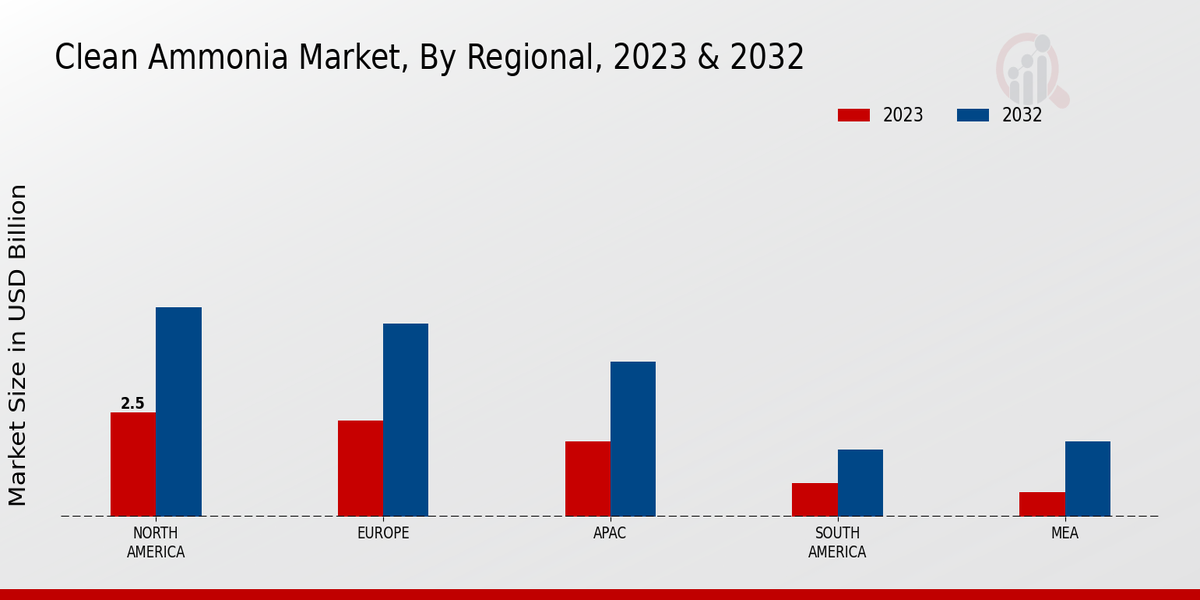Market Growth Projections
The Global Clean Ammonia Market Industry is poised for substantial growth, with projections indicating a market value of 9.28 USD Billion in 2024 and an anticipated increase to 19.7 USD Billion by 2035. This growth trajectory suggests a compound annual growth rate of 7.07% from 2025 to 2035. Such projections reflect the increasing recognition of clean ammonia's role in achieving sustainability goals and transitioning to a low-carbon economy. The market's expansion is likely to be driven by technological advancements, government support, and rising demand across various sectors.
Government Initiatives and Support
Government initiatives play a crucial role in propelling the Global Clean Ammonia Market Industry forward. Various countries are implementing policies and providing financial incentives to promote the production and use of clean ammonia. For example, the European Union has set ambitious targets for ammonia production as part of its Green Deal, aiming for a significant reduction in carbon emissions. Such supportive frameworks not only encourage investment in clean ammonia technologies but also foster innovation in production processes. This trend is likely to contribute to the market's growth, with projections indicating a rise to 19.7 USD Billion by 2035.
Rising Demand for Sustainable Energy Solutions
The Global Clean Ammonia Market Industry is experiencing a surge in demand for sustainable energy solutions. As countries strive to meet climate goals, clean ammonia emerges as a viable alternative to fossil fuels. This shift is driven by the need to reduce greenhouse gas emissions and enhance energy security. For instance, nations like Japan and Germany are investing heavily in ammonia as a hydrogen carrier, facilitating the transition to a low-carbon economy. The market is projected to reach 9.28 USD Billion in 2024, reflecting the growing recognition of clean ammonia's potential in the global energy landscape.
Emerging Global Partnerships and Collaborations
Emerging global partnerships and collaborations are shaping the future of the Global Clean Ammonia Market Industry. Countries and companies are increasingly recognizing the importance of collaboration in advancing clean ammonia technologies. Initiatives such as international research partnerships and joint ventures are facilitating knowledge sharing and resource pooling. For example, collaborations between energy companies and research institutions are focusing on developing scalable clean ammonia production methods. These partnerships not only accelerate innovation but also enhance the market's resilience against economic fluctuations, positioning clean ammonia as a key player in the global energy transition.
Growing Applications in Agriculture and Industry
The Global Clean Ammonia Market Industry is witnessing expanding applications in agriculture and various industrial sectors. Clean ammonia serves as a crucial component in fertilizers, contributing to food security and sustainable agricultural practices. Additionally, its use in industrial processes, such as the production of chemicals and plastics, is on the rise. The increasing need for sustainable agricultural inputs and the push for greener industrial practices are likely to bolster demand for clean ammonia. This trend aligns with the projected compound annual growth rate of 7.07% from 2025 to 2035, indicating a robust market outlook.
Technological Advancements in Ammonia Production
Technological advancements are transforming the Global Clean Ammonia Market Industry, making production processes more efficient and environmentally friendly. Innovations such as electrochemical synthesis and renewable energy integration are enhancing ammonia production's sustainability. These technologies reduce reliance on fossil fuels and lower carbon emissions, aligning with global sustainability goals. For instance, the development of green ammonia production methods is gaining traction, with several pilot projects underway worldwide. As these technologies mature, they are expected to drive down costs and increase the competitiveness of clean ammonia, further stimulating market growth.











